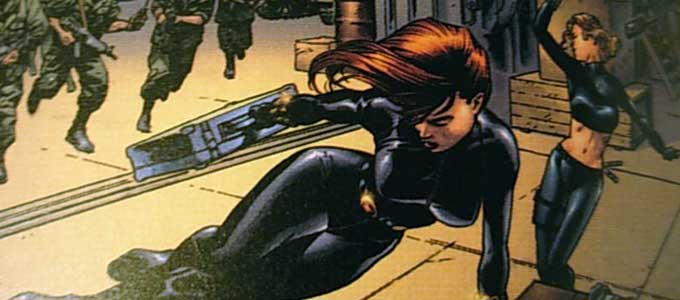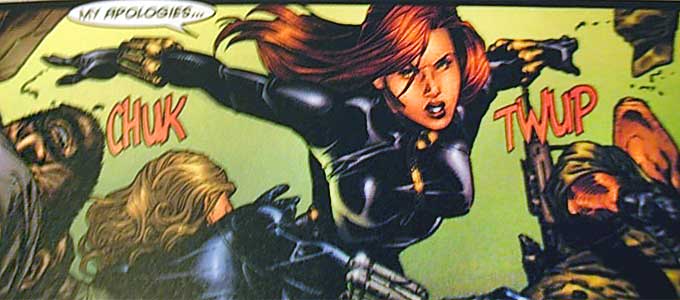This page may contain one or more affiliate links, which means that if you purchase a product through that link, I may receive compensation. The links will be identified with the text "affiliate link". Click to learn more.
I don’t come across the work of JG Jones too often, but I recognized it immediately when I spotted the cover of Black Widow 1, some Marvel Knights thing from 1999. This is a great treasure if you can get your hands on it. The artwork is amazing. I don’t want to reveal too much about the plot of this comic, but it involves two assassins gunning for each other. There is also a cameo by Daredevil, with a not-so-subtle reference to them being lovers. The pencils by Jones in this first issue of Black Widow is superb, like I’ve said already, but the coloring makes his beautiful pencils of sexy women look like plastic dolls. Another reason why coloring with computers is stupid.
In the Marvel Knights comic book series, Black Widow issue 1, released back in 1999, both the artwork and characters play a significant role in capturing the reader’s attention and setting the stage for an engaging narrative. Created by Devin Grayson and JG Jones, this issue showcases a visually stunning style that complements the heroes and villains featured in the story. The detailed and vivid illustrations allow readers to gain a deeper understanding of the characters and their motives, bringing each personality to life. With a diverse roster of compelling characters at the forefront, this first issue of Black Widow not only enthralls fans but also sets the stage for future thrilling adventures.
The story delves into the life and struggles of Natasha Romanoff, the titular character. As a skilled spy and former KGB operative, she battles against the demons of her past while trying to navigate the complex world of espionage. This high-octane adventure draws in readers with its stunning visuals and intricate plotlines intertwined with Marvel’s shared universe. The story, at its core, is an exploration of Black Widow’s resilience and determination to forge a new identity, even in the face of extreme adversity.
If you know me, then you know that I love the advertisements in comic books as much as the main story. Beside Black Widow 1 from Marvel having loads of action and great artwork, there is also a fun two-page spread for the Kubert School correspondence courses. The Kubert School is a school that teaches about how to make comics. All in all, it is no wonder this comic has become such a collectable. Black Widow is a fun read and a great addition to your collection, if you can find it. As usual, it is just better to find (Affiliate Link) the Black Widow graphic novel, than trying to find all the individual issues.
History of Artist JG Jones
Jones was born in San Francisco, California in 1962 and grew up loving drawing and comic books. He drew inspiration from well-known artists like Jack Kirby, Jim Steranko, and Neal Adams. His career kick-started in the late 1980s when he worked as an illustrator for a number of advertising agencies and magazines. It was only in the mid-1990s that he made his mark on the comic industry scene.
Steven T. Seagle’s The Crusades, a series published by Vertigo Comics, was one of his earliest works that brought him the breakthrough. It is worth mentioning that in this series he showed not only his incredible talent to create detailed and realistic images but also managed to become known among numerous illustrators who were trying to maintain some kind of stylized approach for their own works. In particular, the work he did on ‘The Crusades’ won him a nomination for the Eisner Award for Best Penciller/Inker.
One of his biggest moments came to light in 2003 when he worked together with writer Mark Millar on the miniseries ‘Wanted’ for Image Comics. It was a dark tale about antiheroes who rule the world, and it enjoyed great success both in sales and among critics. The rough illustrations that Jones brought out beautifully complemented the story’s edgy and violent nature, thus earning it cult status. The triumph of ‘Wanted’ meant that Jones now held a very high position among comic book artists worldwide.
He joined writer Grant Morrison in 2008 for DC Comics’ Final Crisis, the eagerly awaited crossover event. The superheroes and god power battle, a series that turned out to be wildly successful, with art by Jones being applauded for the astounding detail and dynamic flair once more. In addition to this, he was involved in ‘Before Watchmen: Comedian/Rorschach’, a prequel graphic novel to ‘Watchmen’, which added to his already towering reputation as an artist.
In the field of arts and graphics, his level of detail and the figures that he adds to his drawings bring characters to life more than words; such talent makes him one of the few exceptional individuals in this industry. His style skillfully combines reality with exaggeration to create an interesting and peculiar aesthetic appeal. Many of his panels have received accolades for their ability to appear like cinematic stills from an action-packed movie.
He has not only worked on mainstream titles but also contributed to independent ones like Strange Fruit or 52, which showcase his abilities. Some of the covers he has created for Batman and Spider-Man series have helped establish him as one of the industry’s truly top talents.
Among his creative outputs, he has gained recognition due to his dedication to mentoring as well as fostering diversity within the realm of comic book publishing. He has also spoken up about the lack of representation in comics and contributed to addressing this by providing guidance and education for budding artists from marginalized backgrounds through workshops and symposiums.


